We grow our own food in a suburban village in the North East of England. Follow us as we keep up the battle to be self-sufficient.
Friday 26 August 2011
Self-Sufficient in Suburbia - June 2011
This is the next edition of Self-Sufficient in Suburbia covering June. We are building a poly tunnel, digging a pond, handling bees, cooking in the kitchen and helping Dad with his allotment.
Hazel nuts in abundance
The growing season is earlier in London and the South East than it is in the North East. As I walk around the local woods next to our village of Sunniside in Gateshead checking out the wild food supplies, I have noticed that hazel is in great abundance. My guess is that it will be a bumper crop. I came down to London a few days ago and have found lots and lots of hazel nuts ready for picking. Indeed, we did pick some and have spent the morning cracking them open and eating them. It's a few weeks yet before hazel nuts will be ready for picking back home but start looking around your local hedgerows, parks and woodlands for them. They are high in protein and oils and are an important part of the self-sufficient diet.
Thursday 18 August 2011
Wartime cooking - marrow stuffed with spam
This was the last of our meals on our 2 week wartime diet. A wartime experience cannot be complete without spam. This recipe - marrow stuffed with spam - also highlights the importance of allotments in feeding the nation during the Second World War. It also helps to highlight how allotments can play a role in feeding Britain in the 21st century, were we to stop them being used for house building or illegitimate car repair businesses.
The soft flesh was scooped out of the marrow after I sliced them down the middle. The stuffing was made from chopped spam (a quarter of a tin), a chopped onion, a bit of corned beef that we hadn't used up and, of course, the great wartime ingredient, breadcrumbs. I added a little bit of lard. Normally not somethig I use, it was the main cooking oil of the Second World War in Britain. As a special treat, we used an ounce of cheese, grated over the top. Given that a person's ration of cheese was 2oz a week, this amounted to an incredibly luxurious meal.
Put in the over at 180C.
We've stuffed marrows before though this is the first time we've used spam as the protein. We rather like stuffed marrows and with the crop we have growing on the allotment, we'll be having more of them over the coming weeks.
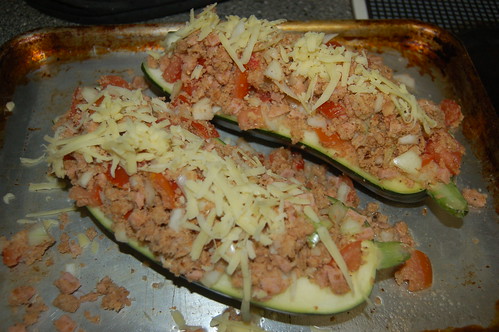
Marrow before cooking
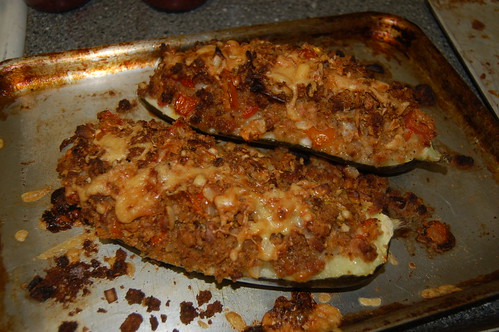
Marrow after baking
Leftovers soup
One of the great lessons from the wartime diet that is useful for those of us setting out to be self-sufficient is waste - or rather lack of it. Nothing is wasted. Food leftovers are not destined for the bin or the compost heap. They are the ingredients for another meal. In this video I put together a load of leftovers and make leftovers soup. Rather tasty as well.
Rabbit burgers
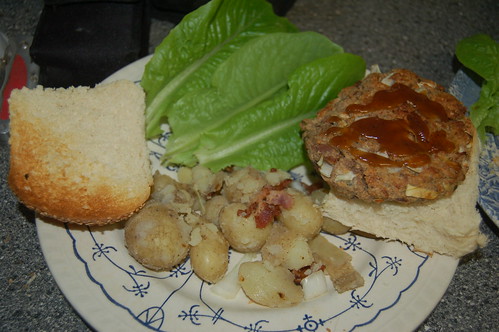
We had some rabbit meat left over from our wartime cooking so we decided to use it to make rabbit burgers. This had the attraction of letting us use up some sausage meat leftover from some other wartime cooking (the potato piglets).
The rabbit was chopped and mixed with the sausage meat, some bread crumbs and some soya flour. There was already some herbs in the sausage meat but I added a chopped onion as well (we picked the main onion crop yesterday).
The burgers were grilled rather than fried. And we had them in a couple of toasted buns. Alas, the buns came from a shop. I haven't had time recently to make bread so I am surviving on the muck that is sold in shops. A few lettuce leaves and a potato salad (we have started harvesting the potatoes) and a splash of homemade hawberry ketchup and the meal was complete.
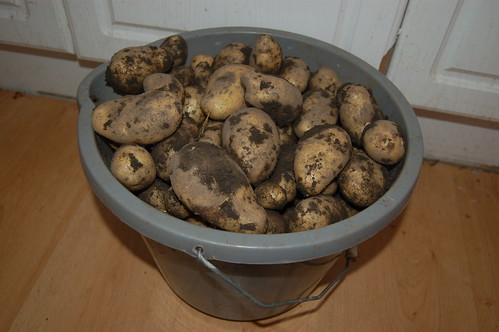
The first potatoes harvested from the allotment.
Wednesday 17 August 2011
Wartime curried rabbit
As part of our wartime diet experience we launched a counterattack on the army of rabbits that takes such a toll on my brassicas. I found a recipe in a 1940 cookbook for curried rabbit. The quantity of curry powder used was tiny (half a teaspoon) for the whole rabbit so this was more a hint of curry than something we, in the early 21st century, would regard as an actual curry. I also suspect that modern food is so packed full of added flavourings and enhancers that our taste buds are shot to bits. I could barely taste the curry in the rabbit. Nevertheless, it was fun to try.
Rabbit was not part of the meat ration so if you got one, it was in addition to your basic meat allowance. Having spoken to many people who lived through the period, though the price of rabbit was controlled by the government, in rural areas in particular, rabbit was often traded for other foods. Across Britain, many people kept rabbits in hutches in their back gardens. They often joined together to form rabbit clubs to share experience, information, feed and time to produce rabbits for the pot.
Monday 15 August 2011
Wartime potato crisps
These are nothing like the crisps that are consumed nowadays. Instead, this is another wartime recipe that used up a kitchen waste - potato peelings - that would otherwise be thrown out. Potato skins are the most nutritious part of this vegetable so it is useful to find ways of using peelings regardless of whether we are at war or not.
To make wartime potato crisps, dry off the peelings (make sure the potatoes are scrubbed before peeling them). Put a bit of oil onto a baking tray and put it in an oven at 200C. To make this more realistic of the time, we used lard but a small amount is all that is needed - enough to give a thin layer over the bottom of the tray.
When the oil or lard is hot, scatter the peelings over the tray and then sprinkle some herbs or curry powder over them. Return the tray to the oven and roast for up to 15 minutes. They should come out crisp and tasty. We are definitely making these again.
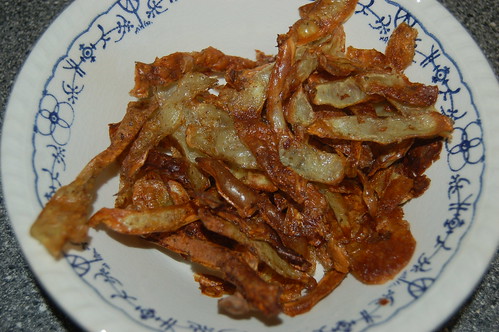
Wartime cooking - bangers and mash
Our plan had been to have toad in the hole to see how people coped with different ingredients to those normally used. We were able to make the sausages but the batter was a disaster. Fortunately I tested the batter before using up our precious sausages. I used whole meal instead of plain white flour (which was not available for much of the war) and I used powdered egg (or rather, a modern day powdered substitute). If people made toad in the hole during the war, I'm at a loss as to how they made an edible meal. Instead, we decided to have bangers and mash.
We decided to opt to relive the diet of 1942, perhaps the most extreme of the war years when meat shortages in particular were attheir worst (though they got worse still in 1946-8.) So sausage meat was part of the meat ration (it was on rations 1942-4). We had to make sure the sausage meat stretched to cover a number of meals. To ensure we could do this we did what they did during the war - added additional ingredients. Most of the extra bulk came from bread crumbs - a great way to use up stale bread. Since most of our wheat continued to be imported, everyone was under immense pressure to avoid wasting bread. It may have been off the ration, but anyone caught feeding bread to ducks in the local park was liable to prosecution.
Also added into the sausage meat was one of our precious onions - again showing that having the allotment was a great bonus when it came to additional food and getting into our diet foods which were difficult to get at the shops. We also added a bit of lard though we had to ensure it was used sparingly as cooking fats were rationed. The final ingredient was soya flour. This is high in protein but had to be imported. As a food concentrate it took up only limited shipping space. It was an important addition to various foods. If you bought wartime sausages, (as opposed to sausage meat) they would almost certainly contain much more breadcrumbs than meat so soya flour was added to them to improve their protein content.
Once all the ingredients are mixed together, shape them into sausages and try them skinless (skins were difficult to get during the war).
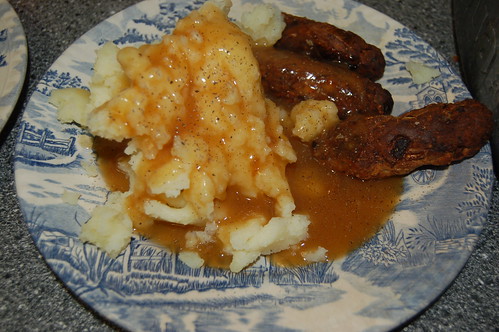
Wartime cooking - potato piglets
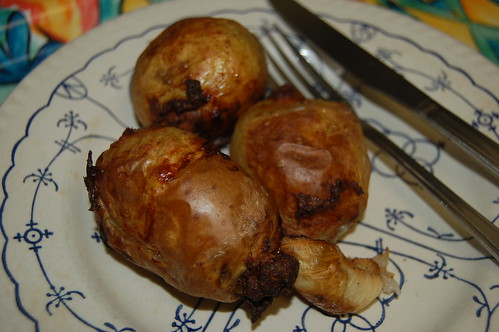
Sausage meat was rationed from 1942-44. Even when it was not on the ration, care needed to be taken to stretch out the sausage meet over a number of meals. I came across this recipe for potato piglets in a cook book published by Durham County Council in 1940. It is simple and easy to do.
The only bit we have changed from the original recipe is to add some herbs to the sausage meat.
Make a hole right through a potato and fill it with sausage meat. Then bake in a hot oven until the potato and sausage are cooked right through. Serve hot.
Wartime cooking - mock orange marmalade
Some foods that were common before the war were either very difficult or impossible to get during the war. Oranges were available during the war but only in small numbers and the ones that were sold in the shops were normally reerved for children. Yet orange marmalade had been a staple of the British breakfast table. How was Britain to cope without her favourite preserve.
The answer was to make a mock orange marmalade. It contains no orange at all but is made instead from apples and carrots! Here's how to make it:
Chop a handful of apples and put them in the jam pan. Cover with water and bring to the boil. Leave simmering for 2 hours.
Strain the resulting pulp through a jelly bag and measure the liquid. Put this into a pan and add in two grated carrots and two teaspoons of orange flavouring. Bring to the boil.
At this point you need to add sugar. Wartime preserves had far less sugar in their jam than nowadays and I suspect the amount I used in this recipe was on the generous side for the war years though 30% less than I use now.
Bring back to the boil and check for the setting point. Once reached, added to sterilised jars.
During the war, your preserve ration was one pound of jam per person every two months. If you gave up your preserve ration, you could get a bit extra sugar to make preserves. Given the meagre preserves ration, making your own instead was a good idea. It was dependent however on having a supply of fresh, locally grown fruit. Most of our fruit was imported before the war and so, from 1939-45, fresh fruit of all types was in short supply (and in some cases such as bananas virtually impossible to get). The Government's efforts to ensure we had our 1940s equivalent of "5 a day" was based on getting us to eat fresh vegetables, especially potatoes and carrots. Britain could be self-sufficient in basic vegetables, even if some, such as onions, had previously been imported.
In this recipe I used wild apples. And picking wild fruit was something that many more people did back in the war years.
By the way, the mock marmalade worked very well.
Tuesday 9 August 2011
How to make raspberry and whitecurrant jam - the video
I made raspberry and whitecurrant jam a few weeks ago so there's the video. And if you don't want to view me making it, here's the recipe:
Equal weight of raspberries and whitecurrants - put them into a jam pan and boil them.
When the fruit has broken down, add sugar - the same weight as total weight of fruit.
Bring back to the boil and keep boiling until the setting point is reach (put a small amount of jam on a plate and if it forms a skin, it's reached the setting point.)
Then add to warmed, sterilised jars.
How to make a Lord Woolton pie - the video
For three days last week, whilst on our wartime diet, we had Lord Woolton vegetable pie for dinner. I rather liked it and we will be adapting it to the 21st century once we have finished reliving the 1940s. (Given what is happening in London at the moment, some people there must feel like they are bing forced to relive the blitz.) Anyway, this is the video of how I made the pie.
Saturday 6 August 2011
How to prepare wood pigeon
We recently traded jam for 19 wood pigeons. This is the first time we have had wood pigeon but I had to learn how to prepare them for use. It turned out to be different to pheasant and duck which I have plucked and gutted in the past.
The only usable part of the wood pigeon is the breast. Instead of plucking the whole bird, pluck along the centre of the breast. Then cut and peel back the skin to reveal the breast meat. Cut the breast fillets off the carcass.
The rest of the bird unfortunately cannot be used for anything (unless anyone can send me information otherwise).
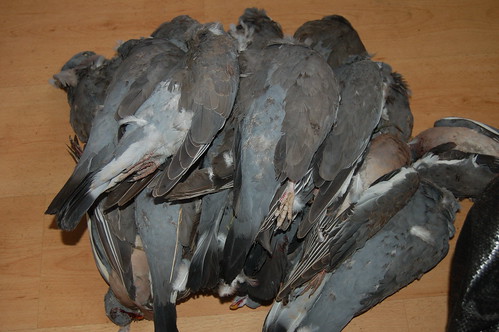
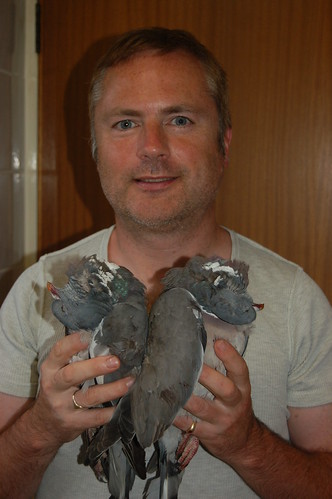
Wartime mint tea
Tea was rationed during the war to 2oz (50g) a week. During our 2 weeks on the wartime diet, we aren't sure the ration will last the course. As a heavy tea drinker, I have had to come up with alternatives. So I am drinking mint tea between meals.
Friday 5 August 2011
Wartime cooking - potato salads
The first of my videos about how we are getting on with our wartime diet. It's lunchtime on day one and already the allotment is proving to be useful.
Thursday 4 August 2011
How to make redcurrant jelly
After a good crop this year of red currants, I made some redcurrant jelly. This is how I made it.
Wartime diet day 3
It is now the end of day 3 of our wartime diet. The Lord Woolton vegetable pie is now finished but we will make it again in the future, after the two weeks of reliving the war are over. Lunch again was bread and marmite.
So far we have not touched our meat rations but tomorrow I will be making toad in the hole, using powdered egg, powdered milk, wholemeal flour and sausages made from a small quantity of sausage meat, bread crumbs, an onion from the allotment and soya flour. The latter was an important ingredient for wartime sausages. It is high in protein but had the extra advantage of being a concentrated food so could therefore be imported without taking up too much shipping space.
So far we have not touched our meat rations but tomorrow I will be making toad in the hole, using powdered egg, powdered milk, wholemeal flour and sausages made from a small quantity of sausage meat, bread crumbs, an onion from the allotment and soya flour. The latter was an important ingredient for wartime sausages. It is high in protein but had the extra advantage of being a concentrated food so could therefore be imported without taking up too much shipping space.
Frog in the pond
Our new pond has a new occupant, a tiny little frog. It's obviously one that was spawned earlier this year. The pond was dug in the late spring so it was too late for frog spawn for this year so it must have come from another pond nearby. We set up the pond to encourage frogs and other bug eating amphibians onto the allotment so we are delighted it is already working. We also have a fully grown frog living in our greenhouse aat the moment. We had one living there last summer as well.
Work on the pond is not yet completed. We need to add more plants, build up one side and tidy up the edging. And we are thinking of adding some fish to eat the mosquito larvae.
Work on the pond is not yet completed. We need to add more plants, build up one side and tidy up the edging. And we are thinking of adding some fish to eat the mosquito larvae.
Wednesday 3 August 2011
The start of our wartime diet: Lord Woolton pie
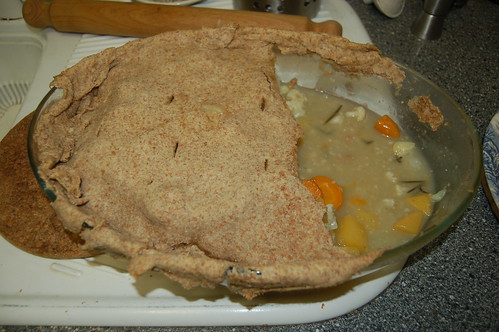
Above and below - Lord Woolton pie

I am now at the end of my 2nd day on a wartime diet. The biggest change I am trying to grasp is the concept of once the ration is used, there's no going to the shops to top up. If something is used up, that's it, there's no more until the next ration period. So everything has to be used very carefully. Meals have to be planned in advance.
This was brought home to me when I made my first wartime recipe yesterday, Lord Woolton pie (named after the Minister of Food). As with so many recipes of the period, it was invented (by the head chef of the Savoy) to use effectively the food resources available to Britain. One of the props of wartime food policy was fresh vegetables. They were produced in the UK therefore avoiding the need to use valuable shipping space to import them.
The jolt to my system was making the pastry. We used 3oz of cooking fat. Our ration was 4oz for a person per week. Fortunately the pie will last both of us for three evening dinners each.
The recipe is:
1lb each of potatoes, carrots, cauliflower and swede. We also added an onion. These were worth their weight in gold. Before the war, most of Britain's onions came from the Continent. Once war was underway, that supply was shut down. Britain therefore had a massive onion shortage. People with allotments could grow onions and many did, helping to supplement the national supply. Our allotment is clearly already working for us on our wartime diet as it was one of our own onions that we used.
Boil the vegetables with a tablespoon of oatmeal and a bit of vegetable stock until the veg has softened. Then add them to a pie dish. Add some herbs (fresh or dry - we used fresh from the allotment) and then top it with wholemeal pastry. White flour was virtually outlawed in 1942 as to make it requires more wheat than is needed to make the same weight of wholemeal flour. And wholemeal is more healthy anyway.
Don't glaze the pastry with milk. It was rationed to 3 pints a week per person so it can't be used for decorative purposes. Bake the pie in the oven for about 25 minutes at 180C.
Lunch over the past two days has been a potato salad. Potatoes were one of the key wartime foods and it is likely that we would have come close to starvation if we were not growing so many ourselves. Growing potatoes produces more calories per unit of land than most other crops so it made sense for Britain to maximise the amount of land used to grow them. Government propaganda of the time also encouraged people to eat potatoes instead of bread.
I can however envisage a time over the next two weeks when I get sick of potatoes unless we have a way of turning them into lots of different dishes. For the two wartime lunches so far we have discovered by accident that having pickle with the potatoes improves the meal. I put pickle in David's lunch yesterday and forgot to add it to mine. When we compared notes we realised the omission.
With the salad today I decided to ignore at least partly government requests to eat potatoes instead of having bread by having both! The reason for this was simple: I was getting short of boiled potatoes. Having taken wartime advice to cut down on use of fuel, I boiled up two days' worth of potatoes on Sunday evening in one go. By lunchtime today, I was running short so I had in addition tot he salad two (small) slices of bread spread with marmite which, helpfully, is not rationed. I also needed something a bit more savory than a simple salad.
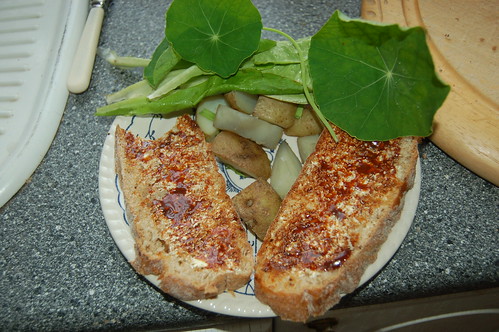
We have now sorted out how we deal with tea. We have 2oz each a week of loose leaf and I was fearing that, as a heavy tea drinker, I would be through it in no time. Through the day I am having a cuppa that consists of mint tea. After a bit of experimentation, we have worked out that for real tea, we need to keep the tea leaves in the pot rather than empty them out and reuse them a bit later. We simply add a bit more tea to the pot (having removed any cold liquid first). At the end of the day, when the tea leaves in the pot have been done to death, we can throw them away (into the compost bin).
I had a shock yesterday when I went to the shops to get some of my rationed goods. We are rationed to 2oz of cheese each per week. Have you seen how small that amount is? The shop didn't even sell it in such small quantities. I had to buy 8oz. That's 2weeks' supply for both of us and it still doesn't look much.
And finally, I am beginning to feel hungry between meals. Our modern day lifestyles mean that if we are peckish and the next meal is not for a couple of hours, we still dip into the biscuit box or the fridge for a snack. My guess is that this snacking is one of the biggest contributors to the obesity epidemic. On our wartime diet, there is no snacking between meal, at least of the fatty food variety. I did snack a few minutes ago but that was to eat a carrot! Nevertheless, I am craving for a chocolate biscuit right now!
Subscribe to:
Posts (Atom)